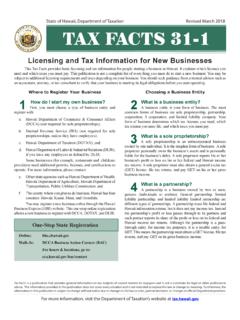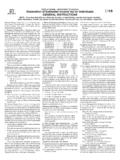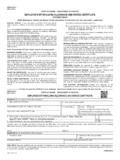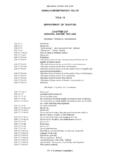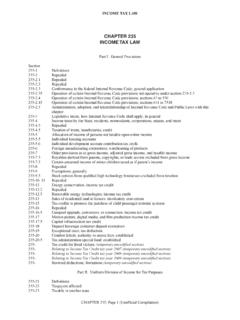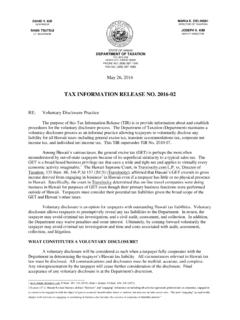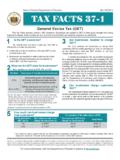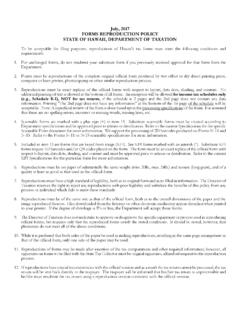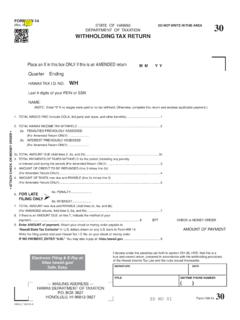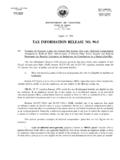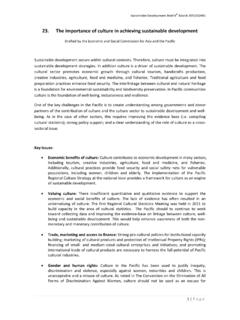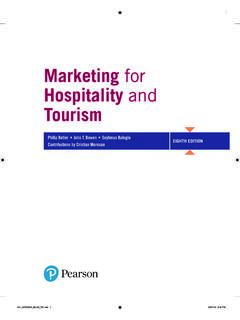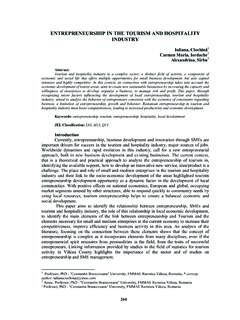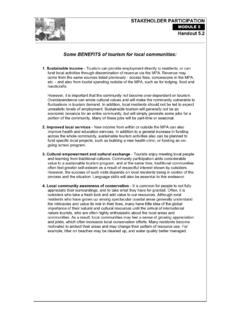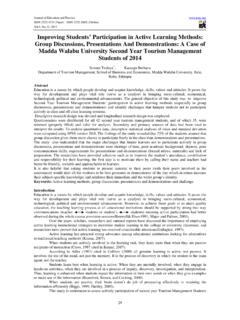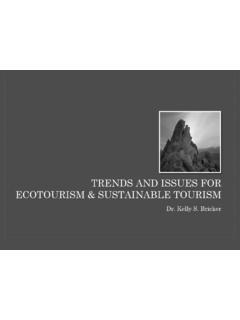Transcription of Tourism in Hawai`i
1 JOHN M. KNOX & ASSOCIATES, INC. _____ 1001 Bishop St., ASB Tower 1542 Honolulu, Hawaii 96813 USA Phone (808) 523-1352 Fax (808) 523-1353 E-Mail Sustainable Tourism in Hawai`i Socio- cultural and Public Input Component Volume III: Socio- cultural Impacts of Tourism in Hawai`i Impacts on Native Hawiians Prepared for the Project: Planning for Sustainable Tourism in Hawai`i Hawai`i State Department of Business, Economic Development & Tourism Prepared by: Sustainable Tourism Study Native Hawaiian Advisory Group (Peter Apo, Dennis Bumpy Kanahele, Cherlyn Logan, Dr. Davianna McGregor) Editing/Facilitation: John M. Knox & Associates, Inc. (John Knox, Aja Kaikilani Devoll) August 2003 Hawaii Sustainable Tourism Study: Socio- cultural Impacts on Native Hawaiians August 2003 Introduction and Contents Page i INTRODUCTORY COMMENT This is the first of a two-part report on Socio- cultural Impacts of Tourism in Hawai`i .
2 The present volume examines impacts on Native Hawaiians in particular, while the second part considers socio- cultural impact issues and impacts for the General Population of Hawai`i . The authors of the present report are the members of the Sustainable Tourism Study s Native Hawaiian Advisory Group: Peter Apo Director, Hawai`i Hospitality Institute Dennis Bumpy Kanahele Director, Kanaka Maoli Research & Development Corp. Cherlyn Logan Vice Pres., Human Resources, Hilton Hotels Western Region Dr. Davianna McGregor Associate Professor, University of Hawai`i Ethnic Studies Dept. John M. Knox & Associates, Inc. provided logistical support, meeting facilitation, reflection on initial drafts, and final editing/formatting. However, the final content is the work of Advisory Group members, and conclusions and recommendations are theirs alone. To our knowledge, this is the first State-sponsored attempt to analyze the visitor industry s impacts on Native Hawaiians from a Native Hawaiian perspective.
3 This report has been cataloged as follows: Hawaii. Dept. of Business, Economic Development and Tourism . Planning for sustainable Tourism . Honolulu: 2005. Multiple volume report by various authors. 1. Tourism -Planning-Hawaii. 2. Tourism -Government policy-Hawaii. 3. Sustainable development-Hawaii. Hawaii Sustainable Tourism Study: Socio- cultural Impacts on Native Hawaiians August 2003 Introduction and Contents Page ii CONTENTS I. PREAMBLE IMPACT ON NATIVE HAWAIIANS: AN OVERVIEW I-1 Fair Reporting I-1 The Challenge I-1 The Business Model I-2 Historical Context I-3 Native Hawaiians and Land I-3 The Good News I-4 Sustaining Native Hawaiian Good Will I-5 II.
4 Tourism IMPACTS ON NATIVE HAWAIIANS: SUMMARY TABLE II-1 III. BEST PRACTICES Criteria and Organization III-1 Categories III-2 1. Special Projects III-2 2. Architecture III-3 3. Accommodations III-3 4. Attractions III-4 5. Environmental Preservation III-5 6. Events III-5 7. Historic Preservation III-6 (Continued) Hawaii Sustainable Tourism Study: Socio- cultural Impacts on Native Hawaiians August 2003 Introduction and Contents Page iii CONTENTS (Continued) 8. Landscaping III-6 9. Literary Arts III-7 10. Broadcast Media III-7 11. Print Media III-8 12.
5 Performing Arts III-8 13. Programs III-9 14. Restaurants and Food Service III-10 15. Retail III-11 16. Visual Arts III-11 IV. RECOMMENDATIONS IV-1 APPENDICES A. MILESTONE HISTORICAL EVENTS IMPACTING THE NATIVE HAWAIIAN PEOPLE AND THE CHALLENGES OF THEIR POLITICAL, SOCIAL, AND ECONOMIC STATUS IN THEIR HOMELAND A-1 B. NATIVE HAWAIIAN cultural IMPACT ASSESSMENT MODEL B-1 C. LIST OF NATIVE HAWAIIAN cultural RESOURCES LOCATED IN COASTAL ZONE MANAGEMENT AREAS C-1 Hawaii Sustainable Tourism Study: Socio- cultural Impacts on Native Hawaiians August 2003 Preamble Impact of Tourism on Native Hawaiians: An Overview Page I-1 I.
6 PREAMBLE IMPACT OF Tourism ON NATIVE HAWAIIANS: AN OVERVIEW FAIR REPORTING This report is a series of observations and perspectives presented by an advisory group of Native Hawaiians. The authors share a long history of being actively engaged in the economic, socio- cultural , and political issues of the Native Hawaiian community. We believe that our collective knowledge represents a deep reach into the community memory and that our authorship lends a measure of credibility for the Native Hawaiian perspectives presented here. Although no such report can occur without some degree of subjectivity, the panel made a great effort at fair reporting. THE CHALLENGE The relationship between Native Hawaiians and Tourism is much more complicated than can be succinctly presented for easy analysis. Budget constraints preclude a comprehensive impact analysis model employing sophisticated analytical tools and technologies that might meet higher standards of fact-finding.
7 Instead, our abbreviated analytical model relies on our own observations of Tourism impacts. To understand the Native Hawaiian view of Tourism , one must be sensitive to the uneasy relationship between Native Hawaiians and the mainstream of Hawai`i s political and economic institutions. The Tourism industry is the dominant sub-set of those institutions. That is, the industry does not exist in a vacuum and therefore cannot be totally isolated as a focal point for study. Tourism has to be considered as part of a larger landscape of historical conditions, circumstances, events, decisions, and attitudes that have resulted in a diminished status of Native Hawaiians as decision makers in Hawai`i s economic future. In this context, Tourism rises as a present-day flashpoint on a long trail of historical disappointments. We believe the majority of Native Hawaiians do not fully and comfortably embrace the prevailing business model of corporate Tourism as generally contributing to the betterment of conditions of Native Hawaiians.
8 We are not trying to say Native Hawaiians would deny that Tourism brings economic benefits or disagree that Tourism is an important activity for the Hawaii Sustainable Tourism Study: Socio- cultural Impacts on Native Hawaiians August 2003 Preamble Impact of Tourism on Native Hawaiians: An Overview Page I-2 State of Hawai`i . But we are saying that, in our experience, many Native Hawaiians feel the industry s growth has contributed to a degradation of their cultural values; compromised their cultural integrity in the global market place; diminished their presence in Hawai`i s visitor centers; devalued their wahi-pana (sacred places); and seriously compromised a Native Hawaiian sense of place in places like Waik k . This assessment is subject to some good news about more positive recent directions, which we will discuss shortly.
9 However, our initial focus must be on the larger picture, which involves the contrast between Native Hawaiian values and the prevailing Tourism business model. THE BUSINESS MODEL The irony is that the Native Hawaiian cultural model of ho`okipa or hospitality the practice of greeting and welcoming strangers ranks high as an important part of our cultural behavior system. Hawaiians have culturally developed our skills as a hosting population to extremely high levels of sophistication. Few societies, if any, are better at hospitality than Native Hawaiians. On the other hand, many of us are emphatically critical of the prevailing business model of Tourism which is structured on a vastly different set of values. In fact, another irony is that Native Hawaiians have long been asking the same fundamental question that prompts this study Is Hawai`i s prevailing Tourism model sustainable? A Tourism experience occurs whenever the three elements of visitor, place, and host converge.
10 Hawai`i employs a typical Tourism business model which makes the visitor the most important element of the three. In the rush to accommodate a visitor s every expectation, this model is now clearly on record as willing to sacrifice the place and the goodwill of the host community for the short term benefit of the visitor. This model eventually turns the place into looking like the place from which the visitor was trying to escape. The preferred business model embraced by Native Hawaiians is a model that makes preserving the dignity and cultural landscape of the place as the most important element. Such models exist all over Europe where protection of the place, the institutions, the historic buildings, the landscapes, and the local cultures are what give these places their market value. Italy is particularly filled with township models such as Florence and Venice, where preservation of the place equals sustainable market share.
